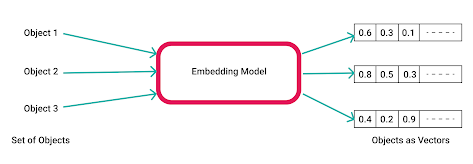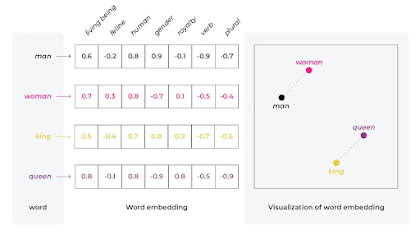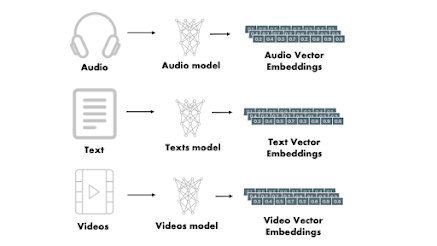Vector embeddings are a powerful tool in natural language processing (NLP) that allows us to represent words, phrases, and even entire documents as vectors of numbers. These vectors can then be used in a variety of NLP tasks, such as sentiment analysis, machine translation, and text classification. In this blog post, we will explore vector embeddings in the context of large language models (LLMs), which are a type of neural network that have revolutionized NLP in recent years. We will cover the basics of vector embeddings, including how they are created and how they can be used in LLMs. We will also provide technical details, equations, and code examples where necessary.
What are Vector Embeddings?
Vector embeddings are lists of numbers that represent some kind of data, such as words, phrases, or images. In the context of NLP, vector embeddings are used to represent words and phrases as vectors of numbers. The idea behind vector embeddings is to capture the meaning of a word or phrase in a way that can be easily processed by a computer. This is done by mapping each word or phrase to a vector in a high-dimensional space, where similar words or phrases are mapped to nearby vectors.
One of the most popular methods for creating vector embeddings is Word2Vec. Word2Vec is a neural network that takes a large corpus of text as input and learns to map each word to a vector in a high-dimensional space. The resulting vectors capture the meaning of each word in the context of the corpus. For example, the vectors for "king" and "queen" will be similar because they often appear in similar contexts.
Another popular method for creating vector embeddings is BERT (Bidirectional Encoder Representations from Transformers). BERT is a type of LLM that is trained on a large corpus of text and can be used to generate vector embeddings for words, phrases, and even entire documents. BERT is particularly useful for NLP tasks that require a deep understanding of the context in which words and phrases appear.
How are Vector Embeddings Used in LLMs?
LLMs are a type of neural network that have revolutionized NLP in recent years. LLMs are trained on large corpora of text and can be used to generate vector embeddings for words, phrases, and even entire documents. These vector embeddings can then be used in a variety of NLP tasks, such as sentiment analysis, machine translation, and text classification.
One of the key advantages of LLMs is that they can generate vector embeddings that capture the meaning of words and phrases in the context of the surrounding text. This is done by using a technique called attention, which allows the LLM to focus on different parts of the input text when generating vector embeddings. For example, when generating a vector embedding for the word "bank", the LLM might focus on the surrounding words to determine whether "bank" refers to a financial institution or the side of a river.
LLMs can also be fine-tuned for specific NLP tasks by training them on a smaller corpus of text that is specific to the task. This allows the LLM to generate vector embeddings that are optimized for the task at hand. For example, an LLM can be fine-tuned for sentiment analysis by training it on a corpus of text that includes labeled examples of positive and negative sentiment.
Code Examples
Creating vector embeddings using Word2Vec involves training a neural network on a large corpus of text. The neural network consists of an input layer, a hidden layer, and an output layer. The input layer takes a one-hot encoded representation of a word as input, and the output layer generates a vector embedding for the word. The hidden layer is where the magic happens - it learns to map words that appear in similar contexts to nearby vectors in the high-dimensional space.
The loss function used to train the Word2Vec neural network is the negative log likelihood of the softmax function. The softmax function is used to convert the output of the neural network into a probability distribution over all the words in the vocabulary. The negative log-likelihood is used to penalize the neural network when it assigns low probabilities to words that appear in the context of the input word.
Here is an example of how to create vector embeddings using Word2Vec in Python:
from gensim.models import Word2Vec
# Load a corpus of text
corpus = ["The quick brown fox jumps over the lazy dog",
"The quick brown cat jumps over the lazy dog"]
# Tokenize the corpus
tokenized_corpus = [sentence.split() for sentence in corpus]
# Train a Word2Vec model on the tokenized corpus
model = Word2Vec(tokenized_corpus, size=100, window=5, min_count=1, workers=4)
# Get the vector embedding for a word
vector = model.wv["fox"]In this example, we first load a corpus of text and tokenize it into a list of sentences. We then train a Word2Vec model on the tokenized corpus, specifying the size of the vector embeddings (100), the size of the context window (5), the minimum count of a word to be included in the vocabulary (1), and the number of worker threads to use during training (4). Finally, we get the vector embedding for the word "fox" using the wv attribute of the Word2Vec model.
Another example of vector embedding is the Universal Sentence Encoder (USE). The USE is a type of LLM that can generate vector embeddings for entire sentences. These vector embeddings can then be used in a variety of NLP tasks, such as text classification, sentiment analysis, and question answering.
The USE is based on a deep neural network architecture called a transformer. The transformer is trained on a large corpus of text and can generate vector embeddings for words, phrases, and sentences. The vector embeddings generated by the transformer are designed to capture the meaning of the input text in a way that is useful for downstream NLP tasks.
Here is an example of how to use the USE in Python:
import tensorflow_hub as hub
# Load the USE model
model = hub.load("https://tfhub.dev/google/universal-sentence-encoder/4")
# Get the vector embedding for a sentence
vector = model(["This is a test sentence."])[0]In this example, we first load the USE model using the hub.load function from the TensorFlow Hub library. We then generate a vector embedding for the sentence "This is a test sentence." using the model function. The resulting vector is a 512-dimensional vector that captures the meaning of the input sentence.
Wrapping-Up
Vector embeddings are a powerful tool in NLP that allow us to represent words, phrases, and even entire documents as vectors of numbers. LLMs are a type of neural network that can generate vector embeddings that capture the meaning of words and phrases in the context of the surrounding text. Vector embeddings and LLMs have revolutionized NLP in recent years and are used in a variety of applications, from sentiment analysis to machine translation. In this blog post, we covered the basics of vector embeddings and LLMs, including how they are created and how they can be used in NLP tasks. We also provided technical details, equations, and code examples where necessary.




Comments
Post a Comment